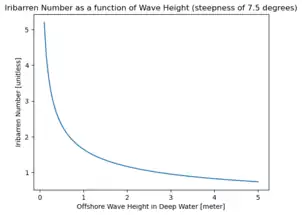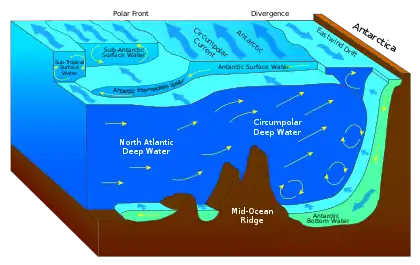


In fluid dynamics, the Iribarren number or Iribarren parameter – also known as the surf similarity parameter and breaker parameter – is a dimensionless parameter used to model several effects of (breaking) surface gravity waves on beaches and coastal structures. The parameter is named after the Spanish engineer Ramón Iribarren Cavanilles (1900–1967),[2] who introduced it to describe the occurrence of wave breaking on sloping beaches.[3] The parameter used to describe breaking wave types on beaches; or wave run-up on – and reflection by – beaches, breakwaters and dikes.[4][5][6]

Iribarren's work was further developed by Jurjen Battjes in 1974, who named the parameter after Iribarren.[4][7][8]
The importance of this parameter for so many aspects of waves breaking on slopes appears to justify that it be given a special name. In the author's opinion it is appropriate to call it the "Iribarren number" (denoted by "Ir"), in honor of the man who introduced it and who has made many other valuable contributions to our knowledge of water waves.
— Jurjen A. Battjes, "Surf Similarity", Proceedings of the 14th International Conference on Coastal Engineering (1974)[4]
Definition
The Iribarren number which is often denoted as Ir or ξ – is defined as:[5]
- with
where ξ is the Iribarren number, is the angle of the seaward slope of a structure, H is the wave height, L0 is the deep-water wavelength, T is the period and g is the gravitational acceleration. Depending on the application, different definitions of H and T are used, for example: for periodic waves the wave height H0 at deep water or the breaking wave height Hb at the edge of the surf zone. Or, for random waves, the significant wave height Hs at a certain location.
Breaker types

The type of breaking wave – spilling, plunging, collapsing or surging – depends on the Iribarren number. According to Battjes (1974), for periodic waves propagating on a plane beach, two possible choices for the Iribarren number are:
- or
where H0 is the offshore wave height in deep water, and Hb is the value of the wave height at the break point (where the waves start to break). Then the breaker types dependence on the Iribarren number (either ξ0 or ξb) is approximately:[4]
| breaker type | ξ0–range | ξb–range |
|---|---|---|
| surging or collapsing | ξ0 > 3.3 | ξb > 2.0 |
| plunging | 0.5 < ξ0 < 3.3 | 0.4 < ξb < 2.0 |
| spilling | ξ0 < 0.5 | ξb < 0.4 |
References
Footnotes
- ↑ Kjeldsen, S.P. (1968), Bølge brydning, fysisk beskrivelse [Wave breaking, physical description] (in Danish), Technical University of Denmark, M.Sc. thesis, 110 pp
- ↑ Real Academia de Ciencias Exactas, Físicas y Naturales (Spanish Royal Academy of Sciences) (2003), Relación de Académicos desde el Año 1847 hasta el 2003 (PDF) (in Spanish), pp. 24–25
- ↑ Iribarren & Nogales (1949)
- 1 2 3 4 Battjes (1974)
- 1 2 Holthuijsen (2007)
- ↑ Bruun (1984)
- ↑ Iribarren Cavanilles, R.; Nogales y Olano, C. (1952). "Spanish practice in harbor design". Coastal Engineering Proceedings. 1(3) (13): 13. doi:10.9753/icce.v3.13. Retrieved 5 December 2022.
- ↑ Schiereck, G.J.; Verhagen, H.J. (2016). Introduction to bed, bank and shoreline protection. Delft, The Netherlands: VSSD. ISBN 978-90-6562-306-5.
Other
- Battjes, J.A. (1974). "Surf similarity". Proceedings 14th International Conference on Coastal Engineering. Vol. 1. pp. 466–480. doi:10.9753/icce.v14.26.
- Bruun, P., ed. (1984), Design and construction of mounds for breakwaters and coastal protection, Developments in geotechnical engineering, vol. 37, Elsevier, pp. xi & 39, ISBN 0-444-42391-5
- Goda, Yoshimi (2010), Random seas and design of maritime structures (3rd ed.), World Scientific, p. 213, ISBN 978-9814282406
- Holthuijsen, L.H. (2007), Waves in oceanic and coastal waters, Cambridge University Press, p. 242, ISBN 978-1139462525
- Iribarren, C.R.; Nogales, C. (1949), "Protection des ports", Proceedings XVIIth International Navigation Congress, Section II, Communication, vol. 4, Lisbon, pp. 31–80
{{citation}}: CS1 maint: location missing publisher (link)

